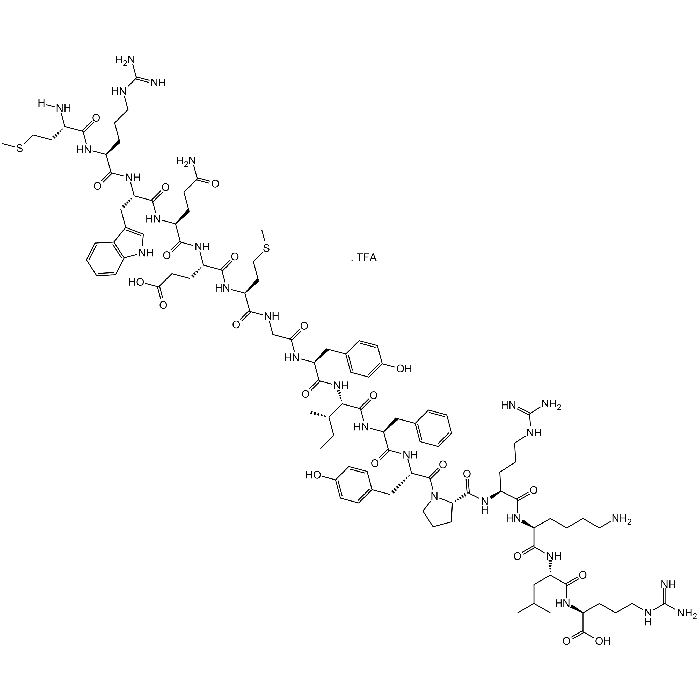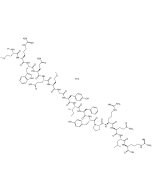Cookie Policy: This site uses cookies to improve your experience. You can find out more about our use of cookies in our Privacy Policy. By continuing to browse this site you agree to our use of cookies.
AdipoGen Life Sciences
MOTS-c (human)
As low as
180
CHF
CHF 180.00
In stock
Only %1 left
AG-CP3-0026-M0011 mgCHF 180.00
AG-CP3-0026-M0055 mgCHF 630.00

| Product Details | |
|---|---|
| Synonyms | H-Met-Arg-Trp-Gln-Glu-Met-Gly-Tyr-Ile-Phe-Tyr-Pro-Arg-Lys-Leu-Arg-OH . TFA; Mitochondrial Open Reading Frame of the 12S rRNA-c; MOTS3 |
| Product Type | Chemical |
| Properties | |
| Formula |
C101H152N28O22S2 . C2HF3O2 |
| MW | 2174.6 . 114.0 |
| Sequence |
H-Met-Arg-Trp-Gln-Glu-Met-Gly-Tyr-Ile-Phe-Tyr-Pro-Arg-Lys-Leu-Arg-OH |
| CAS | 1627580-64-6 |
| Source/Host Chemicals | Synthetic. |
| Purity Chemicals | ≥95% (HPLC) |
| Appearance | White lyophilized powder. |
| Solubility | Soluble in water. |
| Crossreactivity | Human |
| InChi Key | JLKDYZLVBJDJTO-DNWXONKHSA-N |
| Smiles | OC(=O)C(F)(F)F.[H]N[C@@H](CCSC)C(=O)N[C@@H](CCCNC(N)=N)C(=O)N[C@@H](CC1=CNC2=C1C=CC=C2)C(=O)N[C@@H](CCC(N)=O)C(=O)N[C@@H](CCC(O)=O)C(=O)N[C@@H](CCSC)C(=O)NCC(=O)N[C@@H](CC1=CC=C(O)C=C1)C(=O)N[C@@H]([C@@H](C)CC)C(=O)N[C@@H](CC1=CC=CC=C1)C(=O)N[C@@H](CC1=CC=C(O)C=C1)C(=O)N1CCC[C@H]1C(=O)N[C@@H](CCCNC(N)=N)C(=O)N[C@@H](CCCCN)C(=O)N[C@@H](CC(C)C)C(=O)N[C@@H](CCCNC(N)=N)C(O)=O |
| Shipping and Handling | |
| Shipping | AMBIENT |
| Short Term Storage | +4°C |
| Long Term Storage | -20°C |
| Handling Advice | Keep cool and dry. |
| Use/Stability | Stable for at least 1 year after receipt when stored at -20°C. |
| Documents | |
| MSDS |
 Download PDF Download PDF |
| Product Specification Sheet | |
| Datasheet |
 Download PDF Download PDF |
Description
- Mitochondria-derived peptide (MDP).
- Promotes biosynthesis of the endogenous AMP analog AICAR and consequently AMP-activated protein kinase (AMPK).
- Induces cellular and systemic glucose uptake and improves insulin sensitivity. Shown to prevent diet-induced obesity (DIO) in mice.
- Potential anti-obesity and anti-aging compound.
- Involved in cellular stress resistance by regulating the nuclear genome. During metabolic stress (serum or glucose deprivation or oxidative stress) translocates to the nucleus in an AMPK-dependent manner. In the nucleus, MOTS-c binds to the transcription factor NRF2 which is a stress-responsive transcription factor and activates anti-oxidative stress genes.
- MOTS-c has been described as a biomarker for monitoring the progression of Hepatitis B virus infection and as an effective antiviral treatment for patients with chronic hepatitis B.
Product References
- A mitochondrially encoded hormone ameliorates obesity and insulin resistance: K. Zarse & M. Ristow; Cell. Metab. 21, 355 (2015)
- The mitochondrial-derived peptide MOTS-c promotes metabolic homeostasis and reduces obesity and insulin resistance: C. Lee, et al.; Cell. Metab. 21, 443 (2015)
- The mitochondrial-encoded peptide MOTS-c translocates to the nucleus to regulate nuclear gene expression in response to metabolic stress: K.H. Kim, et al.; Cell Metab. 28, 516 (2018)
- The Mitochondrial-Derived Peptide MOTS-c Attenuates Oxidative Stress Injury and the Inflammatory Response of H9c2 Cells Through the Nrf2/ARE and NF-κB Pathways: C. Shen, et al.; Cardiovasc. Eng. Technol. 13, 651 (2022)
- Novel function of MOTS-c in mitochondrial remodelling contributes to its antiviral role during HBV infection: C. Lin, et al.; Gut (epub ahead of print) 2023







